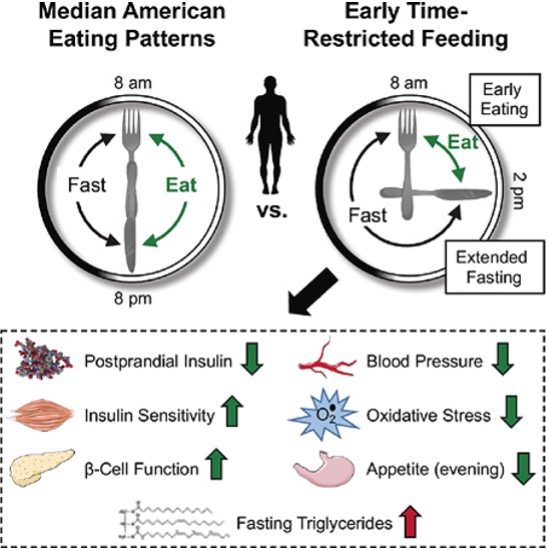Time Restricted Eating is basically a defined time where you limit any caloric intake of food or drink. The different ratios are Fasting: Eating hours. Most intervals use 12-18 hours of fasting and an eating window of 8-10 hrs. This theoretically limits insulin surges and stabilizes blood glucose and overall provides a caloric restriction.
16:8 Example Typical patterns are 16:8 hrs. For example, stop eating at 8pm. Eat back the next day at noon. That’s 16hrs fasting and 8hrs eating (16:8).
14:10 Example. Stop at 6pm and eat at 10am the next day (that’s 14:10).
https://www.cell.com/cell-metabolism/fulltext/S1550-4131(18)30253-5

Fasting Strategies
Fasting does not mean zero calories. Most of the literature uses “fasting” as less than 800 calories a day, so you could pull that lever with TRE or use one of the days as a fasting day. You could implement fasting one or two days in the week, to a ratio of 5:2. Eat typically for 5 days. 2 of those days, use fasting – 800cal or less (water, one meal). This is 5:2 days.
How does intermitting fasting, fasting work? Well, many mention that this is related to overall caloric restriction, but I do believe people find other benefits that make this strategy really useful.
- Enhances food. Yes, when you are waiting 16 hrs for a meal, it sure enhances the food. And, really most do not overeat too.
- Reduces Insulin surges. Obviously if you are not stimulating your pancreas all the time with snacks throughout the day, you reduce insulin surges. This concept drives how I use it in Type 2 Diabetes (and even in Type 1 Diabetes) and those with glucose intolerance. Does this reverse beta cell dysfunction? I don’t know but hopefully longer term data will help answer this important question.
- Reduces Appetite. Crazy as it seems, when you fast for a longer period of time, it can actually reduce your appetite. Probably something to do with fat oxidation (burning), or being in a ketogenic state, or changes in leptin sensitivity or other hormones. Whatever the case, great!
Downsides
There are potential downsides to IF/TRE. Two things are that it may be socially constraining – if you want to have breakfast with people or dinner, etc and you are in your fasting window. How to overcome this? if you want to eat and enjoy company, hell yes!
The other more important concern is that you may be losing muscle > fat, and that all your hard work in the gym is going to impair muscle protein synthesis and lose muscle mass. This one to me, is most significant. And those with this concern must maintain and optimize their protein intake throughout the day.
Well that’s it! Nothing ground breaking here, but something to consider and add to your toolbox! For those interested in reading more, here’s a quick article on Intermittent Fasting – https://health.clevelandclinic.org/intermittent-fasting-4-different-types-explained/
Key Articles
de Cabo R, Mattson MP. Effects of Intermittent Fasting on Health, Aging, and Disease. N Engl J Med. 2019 Dec 26;381(26):2541-2551. PMID: 31881139.
Sutton EF, Beyl R, Early KS, Cefalu WT, Ravussin E, Peterson CM. Early Time-Restricted Feeding Improves Insulin Sensitivity, Blood Pressure, and Oxidative Stress Even without Weight Loss in Men with Prediabetes. Cell Metab. 2018 Jun 5;27(6):1212-1221.e3. doi: 10.1016/j.cmet.2018.04.010. Epub 2018 May 10. PMID: 29754952; PMCID: PMC5990470. https://www.cell.com/cell-metabolism/fulltext/S1550-4131(18)30253-5


